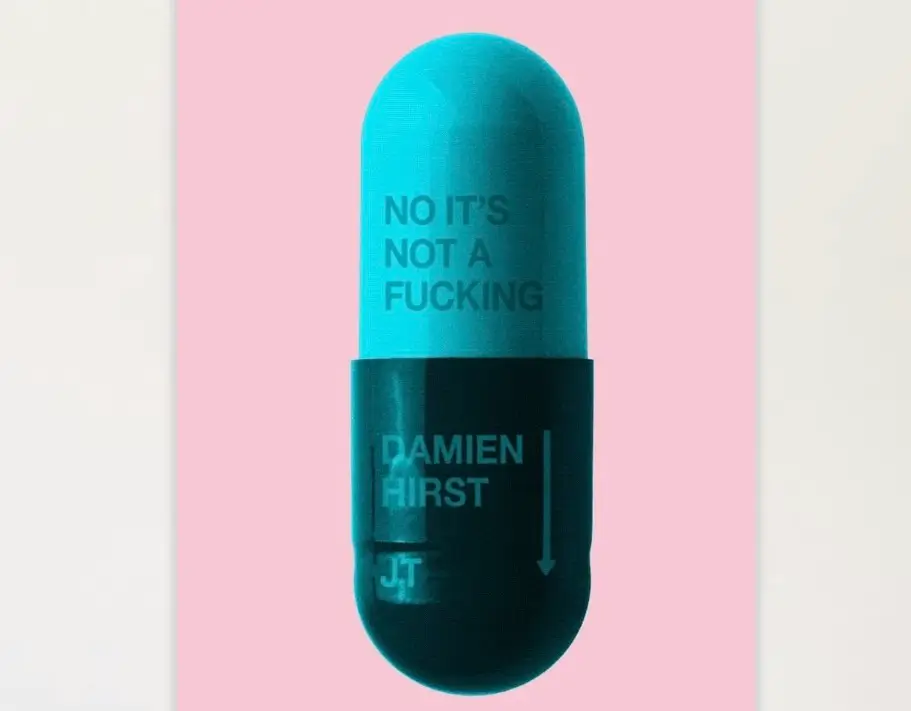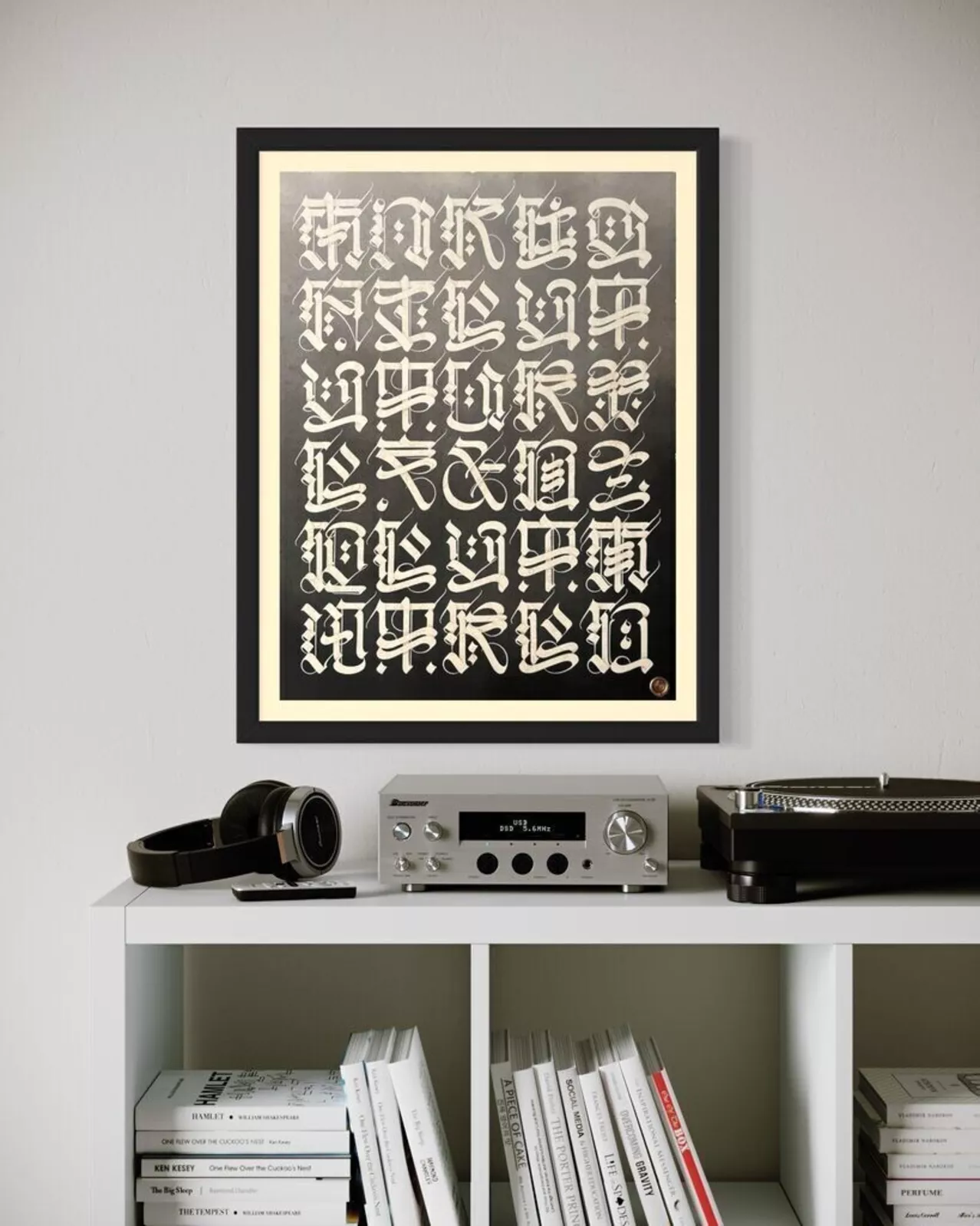James Talon’s Bitter Pill 1 arrives with the same visual jolt as a warning label — bright, direct, confrontational, and impossible to ignore. The limited edition print, one of only thirty, distills the artist’s sharper instincts: satire sharpened into design, digital craft used as a scalpel, and a provocative, almost surgical attitude toward the anxieties of contemporary culture. Though small in scale, the work carries outsized presence, operating simultaneously as a conceptual object and a visual expletive aimed squarely at the contradictions of modern life.
The piece depicts a capsule rendered in icy shades of turquoise and midnight blue, floating dead-center against a flat pink backdrop. The pill’s form is oversized, almost cartoonishly so — inflated beyond practicality into a graphic icon. Across its upper half, in stark capital letters, reads a line that sets the tone for everything that follows: “NO IT’S NOT A F#KING”. The sentence, intentionally unfinished, works as an open door — an interruption, a rebuke, a refusal to be misinterpreted.
The bottom half continues the play in smaller, clinical typography: “DAMIEN HIRST”, followed by the initials “JT”, the artist’s signature. The downward-pointing arrow evokes both pharmaceutical diagrams and assembly-line efficiency. Talon, clearly conscious of the art-world mythologies he is invoking, positions the pill as both an homage and an anti-homage, simultaneously recognizing and rejecting the gravitational pull of a larger figure: Damien Hirst, the British provocateur whose own pill iconography has become as widely recognized as his spot paintings.
stir
At first glance, Bitter Pill 1 reads like a direct satire of Hirst’s pill-themed works, especially his large-scale sculptural capsules and the pharmaceutical aesthetics that have threaded through his practice since the 1990s. But Talon’s approach is not merely referential or derivative. Instead, he extracts Hirst’s visual vocabulary — the bold colors, the clinical fetishization of medicine, the fusion of life, death, and commerce — and twists it into a sharply contemporary statement.
The print’s central phrase, “NO IT’S NOT A F#CKING,” rejects the assumption that any pill-like artwork automatically gestures toward Hirst. Talon exposes a cultural reflex: the tendency to assume that certain materials, symbols, or aesthetics “belong” to certain artists. It is a sly critique of artistic monopolies, of the branding of conceptual territory, and of the art world’s reliance on shorthand associations.
The interruption — refusing to complete the sentence — becomes the punchline. Talon doesn’t need to state what viewers might think. The absence is the commentary.
idea
Even though the work is created digitally, it carries a tactile tension. The print’s smooth gradients, gloss-like finish, and hyper-clean typography mimic product packaging. The rounded capsule shape evokes a pharmaceutical advertisement rather than a handcrafted print. Yet Talon intentionally disrupts the sterile aesthetic with a raw emotional charge tucked inside the typography.
The swear word cements the work’s humanity; it is the rupture that keeps the piece from becoming too clean, too perfect, too ironically detached. Talon seems invested in the idea that digital art should still feel like it was made by a person — not a brand, not a lab, not an algorithm.
The limited edition of thirty prints underscores this commitment. In an era of endlessly replicable digital media, Talon resists pure reproducibility. The scarcity gives the print a handcrafted aura despite its digital origins. It becomes a hybrid object — reproducible yet rare, sharp yet emotional, manufactured yet intimate.
culture
Bitter Pill 1 is not just a joke about art references; it is also a commentary on the psychological landscape of the present moment. Pills occupy a loaded position in contemporary culture: symbols of relief, dependency, imbalance, consumerism, and late-capitalist coping mechanisms. Talon’s oversized capsule becomes a stand-in for everything we medicate, everything we avoid, everything we treat symptomatically rather than structurally.
The pastel pink background, soft and almost sweet, deepens the irony. It resembles the packaging of lifestyle products, Instagram wellness branding, and minimalist therapeutic design — the aesthetics of self-care turned into commerce. The pill itself refuses this softness; its message pierces through the pastel calm like a slip of violent honesty.
Talon’s print captures the contradiction of living in a moment where both anxiety and irony are marketable, where mental health is simultaneously destigmatized and commodified. The pill thus becomes an emblem of cultural contradictions: both a comfort and a critique.
hirst
By invoking Damien Hirst so directly — literally printing his name on the capsule — Talon situates Bitter Pill 1 within the broader lineage of British contemporary art. The gesture is not derivative; it is conversational. Hirst’s influence, particularly his reliance on pharmaceutical symbolism, is undeniable. But Talon’s work challenges the assumption that referencing those forms is a direct imitation.
Instead, he reframes Hirst’s influence as something to engage with and push against. The explicit denial — “NO IT’S NOT A F#CKING” — becomes an act of reclaiming space. Talon speaks to younger artists’ struggle with escaping the gravitational pull of past icons. The pill then becomes both a metaphor for influence and an attempt to break free from it.
This dynamic mirrors earlier artistic dialogues: Warhol and Lichtenstein, Duchamp and Man Ray, Jenny Holzer and Barbara Kruger. Artists respond to one another, sometimes critically, sometimes humorously, sometimes with reverence. Talon’s approach here blends all three.
show
What makes Bitter Pill 1 particularly potent is its use of humor as structural material rather than surface decoration. The humor is not merely a joke; it is the conceptual engine of the piece. The print’s deadpan delivery — a pill floating in void, neat typography, soft background — contrasts sharply with the rawness of the phrase. This clash forces the viewer into awareness, a momentary jolt that mirrors the experience of swallowing a bitter pill.
Talon treats humor as a mechanism for truth-telling, a way to puncture the pretensions of the art world while still participating in its dialogues. The joke is not directed at the viewer but shared with them, forging an unexpected intimacy.
fin
James Talon’s Bitter Pill 1 is deceptively simple at first glance, but within its minimal composition lies a dense network of cultural references, art-historical commentary, emotional undercurrents, and satirical tension. It is a work that holds its own in the lineage of conceptual and post-conceptual art, taking the visual language of pharmaceutical modernity and injecting it with fresh critique.
The print is both a rebellion and an homage, a joke and a warning, a product and an artwork. In an edition of thirty, it stands as a compact but potent dose of Talon’s artistic worldview — a pill that doesn’t promise to make you feel better, but absolutely insists you pay attention.
No comments yet.








